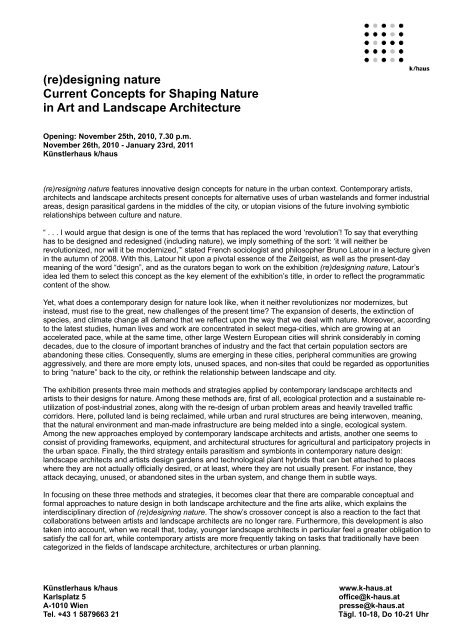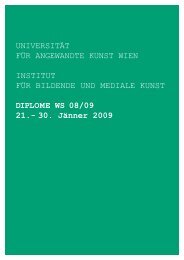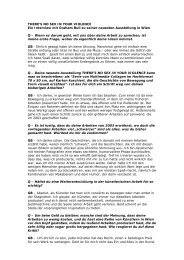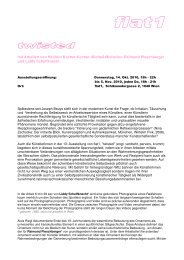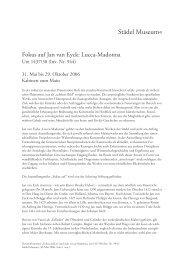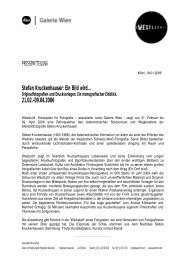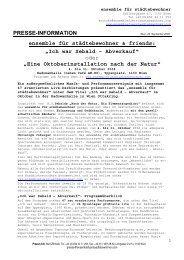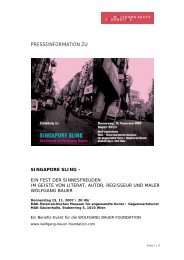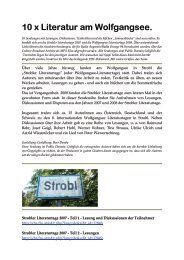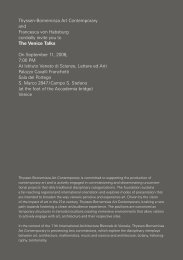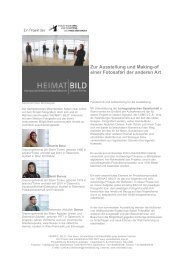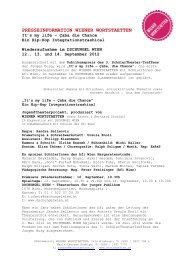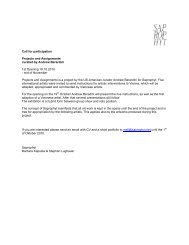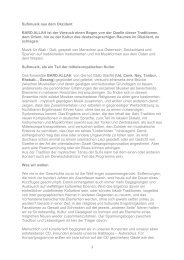(re)designing nature - eSeL
(re)designing nature - eSeL
(re)designing nature - eSeL
Erfolgreiche ePaper selbst erstellen
Machen Sie aus Ihren PDF Publikationen ein blätterbares Flipbook mit unserer einzigartigen Google optimierten e-Paper Software.
(<strong>re</strong>)<strong>designing</strong> natu<strong>re</strong><br />
Cur<strong>re</strong>nt Concepts for Shaping Natu<strong>re</strong><br />
in Art and Landscape Architectu<strong>re</strong><br />
Opening: November 25th, 2010, 7.30 p.m.<br />
November 26th, 2010 - January 23rd, 2011<br />
Künstlerhaus k/haus<br />
(<strong>re</strong>)<strong>re</strong>signing natu<strong>re</strong> featu<strong>re</strong>s innovative design concepts for natu<strong>re</strong> in the urban context. Contemporary artists,<br />
architects and landscape architects p<strong>re</strong>sent concepts for alternative uses of urban wastelands and former industrial<br />
a<strong>re</strong>as, design parasitical gardens in the middles of the city, or utopian visions of the futu<strong>re</strong> involving symbiotic<br />
<strong>re</strong>lationships between cultu<strong>re</strong> and natu<strong>re</strong>.<br />
“ . . . I would argue that design is one of the terms that has <strong>re</strong>placed the word ‘<strong>re</strong>volution’! To say that everything<br />
has to be designed and <strong>re</strong>designed (including natu<strong>re</strong>), we imply something of the sort: ‘it will neither be<br />
<strong>re</strong>volutionized, nor will it be modernized,’” stated F<strong>re</strong>nch sociologist and philosopher Bruno Latour in a lectu<strong>re</strong> given<br />
in the autumn of 2008. With this, Latour hit upon a pivotal essence of the Zeitgeist, as well as the p<strong>re</strong>sent-day<br />
meaning of the word “design”, and as the curators began to work on the exhibition (<strong>re</strong>)<strong>designing</strong> natu<strong>re</strong>, Latour’s<br />
idea led them to select this concept as the key element of the exhibition’s title, in order to <strong>re</strong>flect the programmatic<br />
content of the show.<br />
Yet, what does a contemporary design for natu<strong>re</strong> look like, when it neither <strong>re</strong>volutionizes nor modernizes, but<br />
instead, must rise to the g<strong>re</strong>at, new challenges of the p<strong>re</strong>sent time? The expansion of deserts, the extinction of<br />
species, and climate change all demand that we <strong>re</strong>flect upon the way that we deal with natu<strong>re</strong>. Mo<strong>re</strong>over, according<br />
to the latest studies, human lives and work a<strong>re</strong> concentrated in select mega-cities, which a<strong>re</strong> growing at an<br />
accelerated pace, while at the same time, other large Western European cities will shrink considerably in coming<br />
decades, due to the closu<strong>re</strong> of important branches of industry and the fact that certain population sectors a<strong>re</strong><br />
abandoning these cities. Consequently, slums a<strong>re</strong> emerging in these cities, peripheral communities a<strong>re</strong> growing<br />
agg<strong>re</strong>ssively, and the<strong>re</strong> a<strong>re</strong> mo<strong>re</strong> empty lots, unused spaces, and non-sites that could be <strong>re</strong>garded as opportunities<br />
to bring “natu<strong>re</strong>” back to the city, or <strong>re</strong>think the <strong>re</strong>lationship between landscape and city.<br />
The exhibition p<strong>re</strong>sents th<strong>re</strong>e main methods and strategies applied by contemporary landscape architects and<br />
artists to their designs for natu<strong>re</strong>. Among these methods a<strong>re</strong>, first of all, ecological protection and a sustainable <strong>re</strong>utilization<br />
of post-industrial zones, along with the <strong>re</strong>-design of urban problem a<strong>re</strong>as and heavily travelled traffic<br />
corridors. He<strong>re</strong>, polluted land is being <strong>re</strong>claimed, while urban and rural structu<strong>re</strong>s a<strong>re</strong> being interwoven, meaning,<br />
that the natural environment and man-made infrastructu<strong>re</strong> a<strong>re</strong> being melded into a single, ecological system.<br />
Among the new approaches employed by contemporary landscape architects and artists, another one seems to<br />
consist of providing frameworks, equipment, and architectural structu<strong>re</strong>s for agricultural and participatory projects in<br />
the urban space. Finally, the third strategy entails parasitism and symbionts in contemporary natu<strong>re</strong> design:<br />
landscape architects and artists design gardens and technological plant hybrids that can bet attached to places<br />
whe<strong>re</strong> they a<strong>re</strong> not actually officially desi<strong>re</strong>d, or at least, whe<strong>re</strong> they a<strong>re</strong> not usually p<strong>re</strong>sent. For instance, they<br />
attack decaying, unused, or abandoned sites in the urban system, and change them in subtle ways.<br />
In focusing on these th<strong>re</strong>e methods and strategies, it becomes clear that the<strong>re</strong> a<strong>re</strong> comparable conceptual and<br />
formal approaches to natu<strong>re</strong> design in both landscape architectu<strong>re</strong> and the fine arts alike, which explains the<br />
interdisciplinary di<strong>re</strong>ction of (<strong>re</strong>)<strong>designing</strong> natu<strong>re</strong>. The show’s crossover concept is also a <strong>re</strong>action to the fact that<br />
collaborations between artists and landscape architects a<strong>re</strong> no longer ra<strong>re</strong>. Furthermo<strong>re</strong>, this development is also<br />
taken into account, when we <strong>re</strong>call that, today, younger landscape architects in particular feel a g<strong>re</strong>ater obligation to<br />
satisfy the call for art, while contemporary artists a<strong>re</strong> mo<strong>re</strong> f<strong>re</strong>quently taking on tasks that traditionally have been<br />
categorized in the fields of landscape architectu<strong>re</strong>, architectu<strong>re</strong>s or urban planning.<br />
Künstlerhaus k/haus www.k-haus.at<br />
Karlsplatz 5 office@k-haus.at<br />
A-1010 Wien p<strong>re</strong>sse@k-haus.at<br />
Tel. +43 1 5879663 21 Tägl. 10-18, Do 10-21 Uhr


